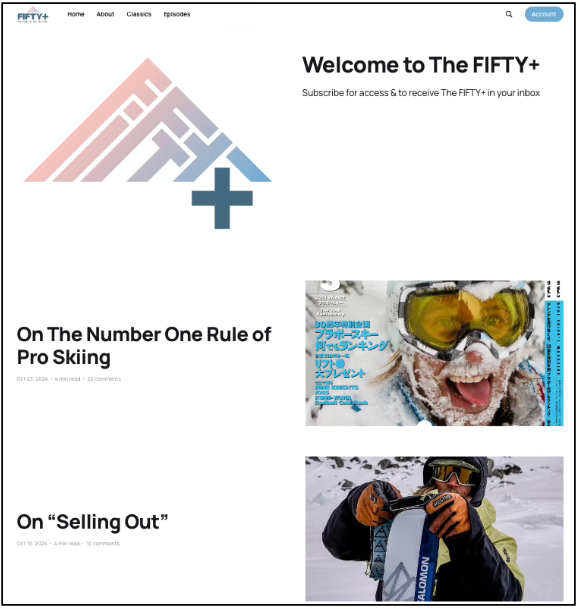The Athlete-Media Revolution: Cody Townsend's Groundbreaking FIFTY+ Strategy
Cody Townsend explains why now is the time for athlete-driven subscription media and how he’s leading the charge with FIFTY+
Happy Halloween everyone!
Over the last few weeks, I’ve been thinking about how creators can to move from primarily making content into a more entrepreneurial stance. Essentially, what is the future model of the individual as micro-media company?
As this was all percolating in my head, the legendary skier and old friend Cody Townsend just launched a new subscription media product called FIFTY+, which is an extension of his amazing “The Fifty” project.
I wanted to catch up with Cody, because for years he’s been at the cutting edge of how adventure athletes can build content brands. Cody’s YouTube channel is the most successful channel in snowsports, and he built funding and sustained production for a 5-year video project in “The Fifty.” No one in the outdoors does it better, and he’s as thoughtful and forward-looking as any athlete.
This is part one of a two-part interview. In part one, we talk FIFTY+, athlete-driven subscription media models, and how brands and athletes can work together better.
Next week, we’ll take a week off while election mayhem is likely to consume everything, then we’ll come back on what creator-driven micro-media companies need to do to survive.
This is a long one, so grab a coffee and enjoy.
The Shift to Audience-First Media
Patrick: Give me the elevator pitch of why you are making FIFTY+.
Cody: I want to be accountable to the audience primarily, and the meat of my job as it stands today is being accountable to brands.
Obviously, you have to be accountable to an audience any time you're putting content out there, but there's always this thing dangling in the back of your head, "We have to get a shot of this product, we have to make sure this product is included." Just being accountable to an audience is something from a creative standpoint where I can essentially say more, do more, be just accountable to educating, entertaining, giving value to the audience.
Then the other thing is, I would get people emailing me, putting comments on the bottom of the Fifty videos, like, "I just want to send you money to thank you for making this."
With those people, you realize if you have a diehard fan base and they're willing to pay for your content, then you should create an avenue for that. But, I'm not going to just charge for stuff that I would have given away for free. I want to build more information to be able to connect with those super-fans, if you will.
Patrick: So how does your content change as you build a subscription-driven media brand?
Cody: I always just think: Does this add value for the audience? I know my audience better than any person on the planet because they're my audience. They’ve watched a lot of the things that I've done over the years, and I can see their feedback. I understand what they want to see, so I'm able to deliver more of that. If they walk away going like, "That was awesome," then any sort of content will fit in.
I know my audience better than any person on the planet because they're my audience.
Patrick: What are you seeing in the media landscape that makes you feel like this is the moment to do this?
Cody: Because there seems to be a resurgence in subscriptions for niche media. Both you and I grew up in a monolithic magazine and ski movie environment, and that has degraded quite a bit. Now we're seeing a resurgence. If you're doing it well enough, people will pay for direct access to it.
When everyone said magazines are dead, it wasn't that magazines are dead, it was that the previous model was dead. People are willing to pay for their media; it's just in a different way now.
Obviously everyone talks about the subscription economy, with Substack and independent writers leaving major media organizations with a massive following, and people willing to pay for their content. Within the last two years, it seems like an absolute surge.
Patrick: One of the things that can be tricky as an individual running a media brand is that you end up almost in competition with your sponsors or your advertisers. And so which do you prioritize — your advertiser, or in your case it might be your sponsor, or your own content?
Cody: As of right now, content behind the paywall is going to keep brands out of it. It is paid for by the audience. That's why there will always be a free component to what I do, YouTube and social media, but there’s going to be a delineation between the two.
Brands should know that athletes aren't like magazines, but I feel like they treat us like we're magazines. We put out content, and then in between, we put out advertisements. Like if you see a social media page, it almost fits the format of an old magazine: Content, content, content, advertisement. And that model to me is not an effective model. We already proved it didn't work.
As a brand, to have an athlete on the program means you're buying into that person as a whole, who they are, and why they're influential in a certain space. Not because they have X number of followers, and so your advertising is going to get X amount of views. Treating athletes not as humans, but as view counts and numbers and engagement metrics, I think it's just such a short-sighted way to look at it.
What Audiences Want: Inspiration vs. Advertising
Patrick: You said in a recent article on Fifty+ that the athlete's job is to make the sport inspiring. If I'm a sponsor, how does that inspiration turn into a job for you as a professional athlete?
Cody: I look back at Shane McConkey, the single most influential skier of all time. Sessions, a small clothing brand from Santa Cruz, where I grew up, was the coolest brand in skiing for a while, especially in Northern California, because they were associated with Shane McConkey. And to me Shane was just who he was, and Sessions was able to reap the benefits of that because they associated themselves with him.
That relationship has changed a lot. And in certain ways, I think it's been detrimental to not only the brands themselves but to the athletes as well. The thinking that, "You have to put out X number of Instagram posts per year, otherwise, we won't give you a contract. And at the end, we're going to count them.” It literally takes away from the exact purpose of why you are reaching out to an individual to promote your products. I just find that that relationship, because of the new metrics of social media, has become a bit broken.
To me, the root of being a professional athlete is inspiring people to do that sport, and that grows the pie as a whole. Inspiration comes in many different forms.
Patrick: So, as you move from the high-level inspiration into this really tactical counting posts and hashtags, that’s where the relationship breaks down?
Cody: I one hundred percent do, because I do a lot of work to see what impact I have on the brands I work with. And I know for a fact that those kinds of posts do the worst and have the least impact on the audience.
When I put five consecutive Fifty videos that get, you know, 300,000-500,000 views, and then I just go, "Hey, this is what's in my pack," and make a video about that, that's where people go bananas. There's just much more connection with people.
If you just go, "Hey, here's advertisement X, hashtag X," the audience is just going to kind of gloss over it. It's why in so many cases, influencer marketing doesn't have as much impact as athletes do, in my opinion.
For an influencer, the end goal is… the money-making. As an athlete, the end goal is the sport which they do, finding their own limits, doing things they've always dreamed about.
Patrick: Because influencers don’t use their own voice to talk to the audience, and just regurgitate what the brand tells them?
Cody: Yeah. How do you gain trust in someone who talks like a walking advertisement? It's really hard to delineate between what an athlete is and what an influencer is. But one way I think about it is, for an influencer, the end goal is the sponsorship, the advertisements, the money-making. And as an athlete, the end goal is the sport which they do, finding their own limits, doing things they've always dreamed about. And that's the way I think most people act. They want to live a life centered on joy and happiness and finding challenges and meeting that challenge.
And to me, when you're talking like a walking advertisement, I just don't think there's that much trust built up, at least in our spaces in the outdoor world. I feel like people see very quickly what the end goal is in a person's online profile.
The Brand-Athlete Relationship
Patrick: It brings to mind our previous discussion where you were talking about how sometimes a brand will engage you to talk to your audience but then they want to micro-manage the content.
Cody: Yeah, I think it actually harms the brand, and I think it harms the individual that they're doing it with.
There's a lot of dynamics that happen within an agency or the creative marketing team. When they don't realize, "Hey, we hired this person because they're trusted. We'll let them talk to their audience about our products in a way that's unique to them. That's going to be the most beneficial thing."
The brands that have had the most success with The Fifty Project are Salomon and Smith. They made products that were very specific to what I do in the Fifty, and those products have done incredibly well because they tie into what I'm doing.
It's when you try to undercut that by saying, like, "Hey, Cody, in the Fifty, can you use our product that doesn’t fit your goals of trying to ski this line. But we just want it in there because we know you have a captive audience." That’s where I, as a person, say, "No, you can’t be in this because it doesn’t fit naturally into what I do." But there's pressure to obviously take money if people are offering it, but you can quickly lose your voice, your authority, your trust with audiences.
There's pressure to take money… but you can quickly lose your voice, your authority, your trust with audiences.
Patrick: For somebody who's not working with you for multiple years, how can they approach you in a way that they can communicate what their product is, but then also be hands-off enough to let you run with it?
Cody: Well, I don’t really participate with those. I only sign long-term partnerships because I want the partnership to integrate into my life, meet my values, and have their products help me in my life.
It’s truthful and it's authentic. So I really just try not to participate in pay-per-post because I don’t think it’s beneficial to the audience, I don’t think it’s beneficial to myself, nor do I think it’s beneficial to the brand.
Patrick: Even with these long-term sponsors, do they expect that selling product is part of the ask? Is that something you can do well as an athlete, or is that not what athletes are for?
Cody: No, I don’t think that’s what athletes are for. That’s what stores are for. That’s what paid posting is for. To me, that isn’t necessarily the job. Obviously, there’s an undercurrent when it comes to investing in an athlete relationship, where ultimately the product is the number one goal. The old-school marketing people understand that it’s bigger than that. That directing a post, a video, to an actual sale is not necessarily the goal. Because ultimately, there’s so much more that goes into a brand relationship.
I look at North Face. They hire badass climbers to go to the gnarliest locations, to climb super gnarly peaks, and that’s why they can say, "Never Stop Exploring," because their athletes are proving that they are a brand that never stops exploring.
And then that sells a North Face jacket in Brooklyn because people are like, "Wow, badass enough for Jimmy Chin, it’s probably badass enough for me for walking around New York City." You know, there is something far more that an athlete brings to a brand than just selling a single product.
Patrick: One of the arguments that I’ve made with creator programs, which are sometimes more transactional than what you are talking about, is that it’s almost like a focus group. You’re going to send a product to a bunch of people and give them a little free reign and see what they do with it. If the brands are courageous enough to let their creators push the limits a little bit, you might find things that you didn’t expect.
Cody: Yeah, that makes a lot of sense. Finding what is working for that audience is important. And that’s where the brand identity becomes so centered around athletes. I mean, look at the Jordan brand. The Jordan brand is one of the most successful brands in America and continues to grow while Nike is facing its own challenges. And you’re like, yeah, it’s because it’s tied into the single most iconic athlete in American history.







